6 April 1942:
Bay of Bengal. At about 0600, the three ships of Ozawa’s
Northern Group attack and sink the 5,381-ton Norwegian tanker ELSA. After 0730,
KUMANO and SUZUYA and destroyer SHIRAKUMO attack a six-ship convoy and sink the
4,986-ton American Export Line's EXMOOR (ex-CITY OF ST. JOSEPH), 9,066-ton
British freighter MALDA, 7,718-ton British freighter AUTOCLYCUS and 2,441-ton
British freighter SHINKUANG at 19N, 86E. Ozawa's cruisers also sink 6,622-ton
British freighter INDORA and Captain J. H. Gregory’s British India Line’s
4,921-ton cargo ship SILKSWORTH. About 50 of SILKSWORTH's mostly Chinese crewmen
survive.
Temporarily detached from the rest of Ozawa’s Center Group, YURA and
YUGIRI sink 1,279-ton Dutch merchant BATAVIA en route from Calcutta to Karachi.
YURA and YUGIRI also sink 1,279-ton Dutch freighter BANJOEWANGI and 3,471-ton
British steamer TAKSANG.
The rest of the Center Group, RYUJO, CHOKAI and ASAGIRI, sink five ships:
5,491-ton American freighter BIENVILLE is bombed by RYUJO's aircraft. She is
finished off by gunfire from CHOKAI, and reportedly also from RYUJO, and then by
a torpedo from CHOKAI.
The 6,426-ton British cargo ship GANGES is attacked
by one of CHOKAI's floatplanes and two of RYUJO's aircraft, and is then sunk by
gunfire from the surface ships including RYUJO.
The 2,646-ton British ship
SINKIANG is attacked by aircraft and then likewise sunk by gunfire.
The
5,686-ton American freighter SELMA CITY is bombed by CHOKAI's floatplanes. She
is also attacked and hit by two aircraft from RYUJO, but by then is already
sinking and abandoned.
The 2,073-ton Dutch freighter VAN DER CAPELLEN is
bombed and damaged by RYUJO's aircraft and sinks two days later.
That same day, the 5,268-ton British freighter ANGLO-CANADIAN is attacked
by five aircraft from RYUJO (including two armed with torpedoes) which score one
hit, a bomb which does not explode but which starts a fire. Also that day, RYUJO
launches strikes against Cocanada and Vizagapatam. The 3,827-ton British
merchant MARION MOLLER is damaged at Vizagapatam.
Ozawa's Southern Group sinks four ships. They first encounter disabled
DARDANUS, under tow by the 5,281-ton British ship GANDARA. The three Japanese
ships promptly open fire on the two merchantmen, which are finished off with
torpedoes from AMAGIRI. Two Norwegian vessels are then sunk, 4,434-ton DAGFRED
and 1,515-ton HERMOD.
In all Ozawa's commerce raiding detachment sinks twenty ships of about
93,247 tons during their brief foray in the Bay of Bengal.
9 April 1942: The Attack on the British naval base at Trincomalee:
At
0600, Nagumo's Striking Force launches 132 aircraft led by Cdr Fuchida to attack
the British naval base at Trincomalee, Ceylon (91 B5N2 Kate dive-bombers [18
from AKAGI, 18 from SORYU and 18 from HIRYU, 19 from SHOKAKU and 18 from
ZUIKAKU] and 41 A6M2 Zeke fighters [6 from AKAGI, 9 from SORYU, 6 from HIRYU, 10
from SHOKAKU and 10 from ZUIKAKU]).
The Japanese find the harbor almost empty of warships, but sink the
9,066-ton British merchant SAGAING with three crated Fairey "Albacore" torpedo
bombers and a "Walrus" amphibian she was carrying, and damage the old 15-inch
monitor HMS EREBUS. The non-operational Dutch light cruiser SUMATRA is also hit
by a 800-kg bomb which does not explode. Outside the harbor, southbound
4,784-ton Greek MARIONGA D. THERMIOTIS is damaged by strafing and seven men are
wounded.
At 0755, a Nakajima E8N2 "Dave" floatplane from HARUNA locates an enemy
carrier 65 miles south of the base. Between 0843 and 0853, the Striking Force
launches 85 "Vals", (18 from SORYU, 18 from HIRYU and 18 from SHOKAKU, 17 from
AKAGI and 14 from ZUIKAKU), escorted by 9 "Zekes" (3 each from AKAGI, SORYU,
HIRYU), which sink old light carrier HMS HERMES. 306 RN personnel are KIA, but
hospital ship HMHS VITA, en route from Trincomalee to Colombo, picks up over 600
survivors.
Other sailors are rescued by local craft or swim to shore. Nagumo's
aircraft also find and sink Australian destroyer HMAS VAMPIRE, 8 KIA, corvette
HMS HOLLYHOCK, 53 KIA, oilers ATHELSTANE and BRITISH SERGEANT and Norwegian
merchant ship NORVIKEN.
During the day, nine of the RAF No. 11 Squadron's Bristol "Blenheim"
bombers attack AKAGI and TONE, but score no hits and lose four of their number
to Nagumo's Combat Air Patrol "Zekes"; another "Blenheim" is lost during the
return flight when they encounter three "Zekes" from HIRYU. BatDiv3 and the
Striking Force continue heading SE.
10 April 1942:
About midnight, the fleet changes course to the NE.
During the next 36 hours, BatDiv 3 and the Striking Force gradually bear
southwards again and pass through the Andaman Sea entering the Straits of
Malacca.
11 April 1942:
CHOKAI and Ozawa's Force arrive at Singapore. Ozawa's
flag is transferred to light cruiser KASHII.
13 April 1942:
CHOKAI departs Singapore with destroyer SHIOKAZE.
22 April 1942:
Arrives at Yokosuka.
25 April 1942:
Captain (Vice Admiral, posthumously) Hayakawa Mikio
(44)(former DesDiv 2) is appointed the CO.
3 May 1942:
Drydocked at Yokosuka. Four 25-mm Type 96 AA guns in two
twin mounts are installed abreast the forward funnel. Two 13.2-mm Type 93 twin
machine guns on the forebridge platforms are likewise replaced by 25-mm twin
mounts.
9 May 1942:
Undocked.
13-27 May 1942:
During ATAGO's refit CHOKAI is designated the
temporary flagship of the Second Fleet.
21 May 1942:
Departs Yokosuka for Hashirajima, arriving on the 23rd.
27 May 1942: Operation "MI" - The Battle
of Midway:
CruDiv 4 section 1's CHOKAI and ATAGO (new flagship of the
Second Fleet) depart Hashirajima with Vice Admiral Kondo's Strike Force, Support
Force, Main Body's BatDiv 3/ 1's HIEI and KONGO, CruDiv 5's MYOKO and HAGURO,
DesRon 4's light cruiser YURA, destroyers MURASAME, SAMIDARE, HARUSAME, YUDACHI,
ASAGUMO, MINEGUMO and NATSUGUMO.
14 June 1942:
Returns to Hashirajima-Kure.
14 July 1942:
Designated flagship of Vice Admiral Mikawa's Eighth
Fleet (Outer South Seas Force).
19 July 1942:
DDeparts Hashirajima for Rabaul in company of ASAGUMO
and NATSUGUMO. Vice Admiral Mikawa and staff are embarked on CHOKAI.
25 July 1942:
Arrives at Truk. Vice Admiral Mikawa is briefed by Vice
Admiral (later Admiral) Inoue Shigeyoshi, CinC, Fourth Fleet.
28 July 1942:
Departs Truk for Rabaul in company of DesDiv 16/1's
YUKIKAZE and TOKITSUKAZE.
30 July 1942:
Simpson Harbor, Rabaul. By 1700, Eighth Fleet HQ and its
103-man staff are transferred ashore.
31 July-7 August 1942:
Departs Rabaul for the Moewe Passage (near
Kavieng). Anchors with CruDiv 6's AOBA, KAKO, KINUGASA and FURUTAKA.
7 August 1942: American Operation "Watchtower" - The Invasion of
Guadalcanal, Solomons:
Rear Admiral (later Admiral) Richmond K. Turner's
(former CO of ASTORIA, CA-34) Amphibious Task Force 62, covered by Vice Admiral
(MOH '14/later Admiral) Frank J. Fletcher's (former CO of VERMONT, BB-20) Task
Force 61 and Rear Admiral (later Admiral) John S. McCain's (former CO of RANGER,
CV-4) Task Force 63's land-based aircraft, lands Maj Gen (later
General/MOH/Commandant) Alexander A. Vandegrift's 1st Marine Division on
Florida, Tulagi, Gavutu, Tanambogo and Guadalcanal opening the campaign to take
the island.
7-8 August 1942:
CHOKAI departs the Moewe Passage with CruDiv 6 for
Rabaul. Embarks Vice Admiral Mikawa and staff, then proceeds through the "Slot"
towards Guadalcanal with light cruisers TENRYU and YUBARI and destroyer YUNAGI.
The submarine USS S-38 sights the IJN force in St. George's Channel, but is
unable to attack.
9 August 1942: The
Battle of Savo Island.
Vice Admiral Mikawa aboard CHOKAI leads
CruDiv 6 in a night gun and torpedo action. At 2312, CHOKAI, KAKO and FURUTAKA
each launch a floatplane to provide illumination. They soon report three
cruisers south of Savo.
The Japanese approach W of Savo undetected, surprise and sink Captain
Samuel N. Moore's QUINCY (CA-39) and Captain (later Rear Admiral) Frederick L.
Riefkohl's VINCENNES (CA-44) and heavily damage Captain William G. Greenman's
ASTORIA (CA-34), Captain Frank E. Getting's (former CO of AMC HMAS KANIMBLA)
cruiser HMAS CANBERRA, Captain Howard D. Bode's CHICAGO (CA-29) and RALPH TALBOT
(DD-390) and PATTERSON (DD-392).[3]
CHOKAI takes several hits from QUINCY and ASTORIA that knock out her No.
1 turret and kill 34 crewmen. (See 16 January 2015 below). CHOKAI returns to
Rabaul.
10 August 1942:
At dawn, CHOKAI returns to Rabaul, where Vice Admiral
Mikawa's flag is returned ashore. She is repaired by the 8th Submarine Base Unit
until 17 August. The forward turret is partially restored, so that only its
starboard gun becomes usable.
Savo. In the morning, an American destroyer scuttles and sinks heavily
damaged HMAS CANBERRA. About noon, attempts to salvage heavily listing ASTORIA
fail. She rolls over on her port beam and sinks by the stern at 1216. CHICAGO
undergoes repairs until January 1943.
10-15 August 1942:
Rabaul. CHOKAI undergoes temporary repairs.
19 August 1942:
Redesignated as flagship of the Eighth Fleet.
22 August 1942:
Departs Rabaul for Shortland with destroyer ISOKAZE.
23 August 1942:
Departs Shortland with CruDiv 6 to provide distant
cover for the Guadalcanal reinforcement convoys.
24-25 August 1942:
During the night, floatplanes from CHOKAI, KINUGASA
and light cruiser YURA drop bombs on Lunga Point.
25-26 August 1942:
During the night, floatplanes from CHOKAI, AOBA,
KINUGASA, FURUTAKA and YURA again bomb the Lunga area.
26 August 1942:
Returns to Rabaul.
6 September 1942:
At Rabaul with destroyer ARIAKE.
10 September 1942:
Departs Rabaul. Arrives at Shortland.
16-20 September 1942:
Departs Shortland with destroyer KAGERO.
30 September 1942:
Departs Rabaul.
1 October 1942:
At Shortland with CruDiv 6. Embarks Type 0 Common
shells instead of Type 91 APs.
13 October 1942:
At 0630, Vice Admiral Mikawa departs Shortland for
Guadalcanal with KINUGASA, DesDiv 20's AMAGIRI and DesDiv 30's MOCHIZUKI.
14 October 1942:
CHOKAI and KINUGASA bombard Henderson Field with
destroyers AMAGIRI and MOCHIZUKI.
15 October 1942:
Returns to Shortland.
24-26 October 1942:
Provides cover for a Guadalcanal reinforcement
convoy with KINUGASA.
1-5 November 1942:
Provides cover for another Guadalcanal
reinforcement convoy with KINUGASA.
13 November 1942: The Naval Bombardment of Henderson Field:
Vice
Admiral Mikawa departs Shortland for Guadalcanal with his Main Body's CHOKAI and
KINUGASA, light cruiser ISUZU and destroyers ARASHIO and ASASHIO.
The Main Body accompanies Rear Admiral (later Vice Admiral) Nishimura
Shoji's (former CO of HARUNA) Bombardment Unit's MAYA and SUZUYA, light cruiser
TENRYU, DesDiv 4's MICHISHIO and DesDiv 10's KAZAGUMO, MAKIGUMO and YUGUMO.
CHOKAI launches floatplanes to drop magnesium parachute flares and light targets
for the bombardment of Henderson Field.
14 November 1942:
From 0130-0200, MAYA and SUZUYA bombard Henderson
Field with 989 8-inch shells, then retire towards Shortland. Around 0830,
Captain George E. Dooley's flight of six Marine Grumman TBF "Avenger"
torpedo-bombers from VMSB-131 at Guadalcanal attack a "MOGAMI-class" heavy
cruiser (actually CHOKAI) and claim five torpedo hits (two to the port side and
three to the starboard). In reality, CHOKAI evades all torpedoes, receiving no
damage.
After 1030, CHOKAI is attacked by five Douglas SBD-3 "Dauntless"
dive-bombers from USS ENTERPRISE (CV-6) VB-10, led by LtCdr James A. Thomas.
Ensign Edwin J. Stevens and Ensign Jefferson H. Carroum score two near misses
off CHOKAI's starboard side. The concussion floods some compartments and two
boiler rooms are temporarily disabled, but the cruiser is still capable of 29
knots, arriving at Shortland on that same day. One sailor is wounded. [4]
16 November 1942:
Departs Shortland with destroyers KAGERO, YUGUMO,
MAKIGUMO, KAZAGUMO, OYASHIO and SUZUKAZE.
17 November 1942:
Arrives at Rabaul.
18 November 1942:
Departs Rabaul via Kavieng with SUZUKAZE.
20 November 1942:
Arrives at Truk. Undergoes repairs.
1 December 1942:
Departs Truk.
2 December 1942:
Arrives at Rabaul.
December 1942-10 February 1943:
On station in the Rabaul-Kavieng area.
11 February 1943:
Departs Rabaul.
13 February 1943:
Arrives at Truk.
15 February 1943:
Departs Truk for Japan in company of the escort
carriers JUNYO and CHUYO, BatDiv 3's battleships KONGO and HARUNA, seaplane
tender NISSHIN and heavy cruiser TONE, escorted by six destroyers. After
encountering heavy seas JUNYO and two destroyers are ordered back to TRUK.
20 February 1943:
Arrives at Yokosuka. Refit.
1 March 1943:
CHOKAI is dry-docked at Yokosuka until 13 March. Captain
(Vice Admiral, posthumously) Aruga Kosaku (45)(former ComDesDiv 4) is appointed
the CO. Captain Hayakawa is reassigned as the CO of YAMASHIRO. [5]
4 April 1943:
Departs Yokosuka for Truk via Saeki with a task group
that includes escort carriers TAIYO, CHUYO and destroyers OYASHIO, KUROSHIO,
HIBIKI and SAZANAMI.
7 April 1943:
The task group arrives at Saipan and departs the same
day. USS HADDOCK (SS-231) sights the group but is unable to attack.
9 April 1943:
At 2248, the task group is attacked by USS TUNNY
(SS-282) at 06-07N, 150-28E. The submarine fires all ten of her torpedo tubes,
but most premature or miss. TAIYO receives slight damage as a result of a nearby
explosion.
10 April 1943:
Arrives at Truk with CHUYO and TAIYO.
13 April 1943:
Departs Truk on a troop transport run to Rabaul and
Kavieng with HAGIKAZE.
15 April 1943:
Arrives at Rabaul, later departs for Kavieng.
20 April 1943:
Arrives back at Truk.
30 June 1943:
Departs Truk with DesDiv 17's YUKIKAZE, SUZUKAZE and
KAWAKAZE (the latter returns after grazing a reef).
2 July 1943:
Arrives at Rabaul.
5 July 1943:
Arrives at Shortland.
7 July 1943:
Departs Shortland with DesDiv 11's HATSUYUKI and DesDiv
12's MURAKUMO and SHIRAKUMO.
8 July 1943:
Arrives at Rabaul.
18 July 1943:
CHOKAI and SUZUYA depart Rabaul for the Vella Gulf with
the light cruiser SENDAI and DesDiv 27's YUGURE, DesDiv 31's KIYONAMI and two
other destroyers to cover other destroyers acting as fast transports carrying
troop reinforcements. Off Kolombangara, the group is attacked by
Guadalcanal-based Marine Grumman TBM "Avenger" torpedo-bombers. A near-miss
damages CHOKAI's hull plates aft.
20 July 1943:
Attacked by North American B-25 "Mitchell" skip bombers.
DesDiv 27's YUGURE and DesDiv 31's KIYONAMI are sunk with all hands.
21 July 1943:
CHOKAI returns to Rabaul.
10 August 1943:
Departs Rabaul for Truk.
11 August 1943:
Arrives at Truk.
13 August 1943:
Departs Truk.
16 August 1943:
Arrives at Yokosuka, dry-docked until 11 September for
hull and steering gear repairs. During the same refit a Type 21 surface-search
radar and two additional Type 96 25-mm AA mounts are installed.
20 August 1943:
Reassigned to CruDiv 4, Second Fleet.
15 September 1943:
Departs Yokosuka via Shortland and Rabaul with MAYA
and destroyers SHIMAKAZE and NAGANAMI carrying a SNLF unit.
20 September 1943:
Arrives at Truk.
5-6 October 1943:
Rear Admiral (later Vice Admiral) Alfred E.
Montgomery's (former CO of RANGER, CV-4) Task Force 14's carriers USS ESSEX
(CV-9), YORKTOWN (CV-10), LEXINGTON (CV-16), INDEPENDENCE (CV-22), BELLEAU WOOD
(CVL-24) and COWPENS (CVL-25) launch raids on Wake Island and the Marshall
Islands.
17 October 1943:
The Japanese intercept radio traffic that suggests
the Americans are planning another raid on Wake. The CINC, Combined Fleet,
Admiral Koga Mineichi (former CO of ISE) sorties from Truk to Brown Atoll,
Eniwetok to intercept the Americans with the fleet: BatDiv 1's YAMATO, MUSASHI
and NAGATO, BatDiv 2's FUSO, Bat Div 3's KONGO and HARUNA, CarDiv 1's SHOKAKU,
ZUIKAKU and ZUIHO, CruDiv 4's ATAGO, CHOKAI, TAKAO and the MAYA, CruDiv 7's
SUZUYA, MOGAMI, CruDiv 8's CHIKUMA and TONE, light cruisers AGANO, NOSHIRO and
OYODO and destroyers.
26 October 1943:
Arrives at Truk.
26 October 1943:
At Truk.
3 November 1943:
Departs Truk for Rabaul with CruDivs 4, 7, CruDiv 8's
CHIKUMA and MOGAMI and destroyers to attack U.S. forces that landed at Empress
Augusta Bay, Bougainville on 1 November. Enroute, CHOKAI is detached with
destroyer SUZUNAMI to assist the damaged tankers NISSHO MARU and NICHIEI MARU.
6 November 1943:
Arrives at Truk with tankers.
10 November 1943:
CHOKAI replaces ATAGO as the flagship of CruDiv 4.
20 November 1943: American Operation "Galvanic" - The Invasion of the
Gilberts:
Forces under Vice Admiral (later Admiral) Raymond A. Spruance
(former CO of MISSISSIPPI, BB-41), Commander, Central Pacific, invade Tarawa and
Makin Islands. The invasion fleet of 200 ships includes 13 battleships and 11
carriers.
24 November 1943:
The CHOKAI departs Truk in response to the American
invasion of Tarawa with CruDiv 7's SUZUYA, KUMANO, destroyers HATSUZUKI,
SUZUTSUKI, HAMAKAZE, FUJINAMI and HAYANAMI. Fleet tanker NIPPON MARU provides
support, escorted by the YAMAGUMO, MAIKAZE and NOWAKI.
26-27 November 1943:
At Kwajalein.
28-29 November 1943:
At Eniwetok.
30 November-3 December 1943:
At Roi.
5 December 1943:
Arrives back at Truk.
14 January 1944:
At Truk. CruDiv 4's flag is returned to ATAGO.
Probably at that time ten Type 96 25-mm single mounts are added.
21 January 1944:
Departs Truk to escort supply ship IRAKO torpedoed
the day before by USS SEADRAGON (SS-194).
31 January 1944: American Operation "Flintlock" - The Invasion of the
Marshall Islands:
Vice Admiral (later Admiral) Marc A. Mitscher's (former CO
of HORNET, CV-8) Task Force 58 lands the 4th Marine Division and the Army's 7th
Infantry Division that soon capture the Kwajalein, Roi-Namur and Majuro atolls.
4 February 1944:
Two USMC Consolidated PB4Y-1 (B-24) "Liberator"
photo-reconnaissance planes from Bougainville overfly Truk at high altitude. A
floatplane from the battleship MUSASHI unsuccessfully attempts to intercept
them.
This overflight, combined with the invasion of the Marshalls and recent
radio intelligence decrypts, convince the CinC, Combined Fleet, Admiral (Fleet
Admiral, posthumously) Koga Mineichi (former CO of ISE) to withdraw the major
portion of his heavy units to Palau.
10 February 1944:
Departs Truk for Palau with CruDiv 5's HAGURO and
MYOKO, CruDiv 4's ATAGO and destroyers.
At 2100, USS PERMIT (SS-178) attacks the cruiser force in a night surface
attack at 08-27N, 149-24E, but misses with four torpedoes.
13 February-29 March 1944:
At Palau.
17-18 February 1944: American Operation
"Hailstone" - The Attack on Truk Lagoon:
Task Force 58's five fleet
carriers and four light carriers, supported by six battleships, ten cruisers and
28 destroyers, launch air attacks on Japanese ships in the lagoon, airfields and
shore installations. They sink 31 transports and 10 naval vessels (two cruisers,
four destroyers and four auxiliary vessels), destroy nearly 200 aircraft and
damage severely about 100 more. Truk is eliminated as a major fleet anchorage
for the IJN.
19 February 1944:
Palau. CHOKAI receives fresh provisions
replenishment from stores ship KITAKAMI MARU.
1 March 1944:
CruDiv 4 is reassigned to Vice Admiral Ozawa's First
Mobile Fleet.
11 March 1944:
Palau. CHOKAI receives fresh provisions from KITAKAMI
MARU.
29 March 1944:
CHOKAI sorties from Palau with CruDiv 4's ATAGO, MAYA
and TAKAO and CruDiv 5's MYOKO and HAGURO to avoid anticipated carrier air
raids.
1-4 April 1944:
CHOKAI is at Davao, Philippines with CruDivs 4 and 5.
CHOKAI receives fresh provisions replenishment from supply ship KITAKAMI MARU.
6 April 1944:
The cruiser force is attacked by LtCdr (later Captain)
Bladen Clagett's USS DACE (SS-247), but he misses with six improperly set bow
torpedoes. The cruiser force is also sighted by Cdr William S. Stovall's DARTER
(SS-227), but he is unable to attack.
7 April 1944:
USS SCAMP (SS-277) sights the cruiser force coming out
of Davao Bay, but the submarine is detected and is unable to attack.
9 April 1944:
Arrives at Lingga (S of Singapore). Conducts battle
training exercises during the month.
21 April-3 May 1944:
Seletar Naval Base. Undergoes minor upkeep.
During that time Captain Aruga contracts dengue fever, but still retains command
of the ship.
11 May 1944:
Departs Lingga with CruDiv 4 for the First Mobile Fleet's
advance anchorage at Tawi Tawi.
14 May 1944:
Arrives at Tawi Tawi.
6 June 1944:
Tawi Tawi. After Captain Aruga's condition becomes
critical, Captain Tanaka Jo (47)(former CO of KITAKAMI) is appointed the CO. Due
to lack of suitable shore facilities Aruga has to be treated aboard CHOKAI.
13 June 1944: Operation "A-GO" - The Battle
of the Philippine Sea:
Departs Tawi Tawi with Vice Admiral Ozawa's
Mobile Fleet for Guimaras near Panay, Philippines in Force "C" (less YAMATO,
MUSASHI, MYOKO, HAGURO, NOSHIRO). USS REDFIN (SS-272) sights the Mobile Fleet
departing Tawi Tawi.
14 June 1944:
Guimaras. Captain Aruga is sent ashore and later flown
to Manila. The Mobile Fleet refuels from Supply Force No. 2's oilers GENYO and
AZUSA MARUs.
15 June 1944:
The Mobile Fleet departs Guimaras through the Visayan
Sea and the San Bernardino Strait into the Philippine Sea headed towards Saipan.
At 1622, USS FLYING FISH (SS-229) spots the Mobile Fleet in the San Bernardino
Strait. She reports the sighting that evening.
16 June 1944:
At 1650, Ozawa's force is joined by Vice Admiral Ugaki
Matome's (former CO of HYUGA) aborted Operation "Kon" Task Force from Batjan:
BatDiv 1's YAMATO and MUSASHI, CruDiv 5's MYOKO and HAGURO and DesRon 2's
NOSHIRO.
18-19 June 1944:
At 2100, Ozawa splits the Mobile Fleet. Forces "A"
and "B" proceed southward. Force "C" Vanguard proceeds due east. The Mobile
Fleet's aircraft attack elements of the U.S. Fifth Fleet, but suffer
overwhelming aircraft losses in the "Great Mariana's Turkey Shoot".
20 June 1944:
At 1830, HARUNA, KONGO and carrier CHIYODA are attacked
by Grumman TBM "Avenger" torpedo-bombers from USS BUNKER HILL (CVL-17), MONTEREY
(CVL-26) and CABOT (CVL-28). HARUNA is hit by bombs and damaged by near-misses.
CHOKAI is undamaged and retires with the Mobile Fleet to Okinawa.
24 June 1944:
Arrives at Hashirajima.
26 June 1944:
Kure. Enters dock. Type 22 surface-search and Type 13
air-search radars are probably installed at this time. The AA suite is increased
by twelve Type 96 25-mm single AA mounts.
8 July 1944:
Departs Kure with Group "A's" YAMATO and MUSASHI, CruDiv
4's ATAGO, TAKAO and MAYA, CruDiv 7's KUMANO, SUZUYA, TONE and CHIKUMA, DesRon
2's NOSHIRO with DesDiv 27's AKISHIMO, HAYASHIMO, DesDiv 31's KISHINAMI, OKINAMI
and ASASHIMO, DesDiv 32's FUJINAMI, HAMANAMI and SHIMAKAZE, DesDiv 17's
HAMAKAZE, DesDiv 27's SHIGURE and SAMIDARE and Group "B's" KONGO and NAGATO,
CruDiv 7's MOGAMI, DesRon 10's YAHAGI with DesDiv 17's URAKAZE, ISOKAZE,
HAMAKAZE and YUKIKAZE. CHOKAI carries IJA troops and material to Nakagusuku Bay,
Okinawa.
10 July 1944:
Group A detaches from Group B and departs Okinawa for
Lingga (near Singapore) to join the Mobile Fleet.
16 July 1944:
At 0530, CruDivs 4, 7, and DesRon 2 detach from Group A
for Singapore.
19 July-3 August 1944:
While ATAGO is in drydock at Singapore, CHOKAI
assumes the duties of flagship of CruDiv 4.
22 July 1944:
Singapore. A staff conference dealing with gunnery
problems is held on board CHOKAI. Vice Admiral Ugaki Matome (former CO of
HYUGA), ComBatDiv 1 (former CO of HYUGA) acts as chairman.
14 September 1944:
Lingga anchorage. CHOKAI receives fresh provisions
replenishment from stores ship KITAKAMI MARU.
23 September 1944:
Lingga anchorage. CHOKAI receives fresh provisions
replenishment from KITAKAMI MARU.
18-20 October 1944:
Departs Lingga for Brunei Bay, Borneo with CruDiv
4 and CruDiv 5's MYOKO and HAGURO.
22 October 1944: Operation "SHO-I-GO"(Victory) -
The Battle of Leyte Gulf:
CHOKAI sorties with Vice Admiral Kurita's
First Mobile Striking Force, Force "A "(Center Force): BatDiv 1, CruDiv 4,
CruDiv 5's MYOKO and HAGURO, DesRon 2's light cruiser NOSHIRO with DesDiv 2's
DesDiv 2's HAYASHIMO, AKISHIMO, KIYOSHIMO, DesDiv 31's KISHINAMI, OKINAMI,
ASASHIMO and DesDiv 32's FUJINAMI, NAGANAMI, HAMANAMI and destroyer SHIMAKAZE.
23 October 1944: The Battle of the Palawan
Passage:
At 0633, Cdr (later Captain) David McClintock's USS DARTER
(SS-227) sinks Vice Admiral Kurita's flagship ATAGO and damages TAKAO. Kurita
and his staff are picked up by Cdr Mifune Toshiro's destroyer KISHINAMI. Vice
Admiral Ugaki assumes temporary command of the Mobile Force. Meanwhile, at 0655,
Cdr Bladen Claggett's USS DACE (SS-247) torpedoes MAYA. She sinks at 0705. At
1620, Kurita transfers to the YAMATO and resumes command. CHOKAI is undamaged.
Force "A" is attacked by McClintock's DARTER
CHOKAI is the sole undamaged unit of CruDiv 4. Vice Admiral Kurita
reassigns her to CruDiv 5.
24 October 1944:- The Battle of the Sibuyan
Sea:
Force A endures 11 raids by over 250 aircraft of Task Force 38's
USS ENTERPRISE (CV-6), ESSEX (CV-9), LEXINGTON (CV-16), INTREPID (CV-11),
FRANKLIN (CV-13) and CABOT (CVL-28). Battleship MUSASHI is sunk, NAGATO hit,
HARUNA damaged by near-misses and YAMATO is hit by bombs and down by the bow.
MYOKO is hit by an aircraft torpedo. TONE is hit by bombs. CHOKAI is undamaged.
At 1530, Force "A" reverses course back through the Sibuyan Sea. At 1715,
Force "A" reverses course again. Finally, at 2330, Force "A" enters the San
Bernadino Strait in single file.
25 October 1944: The Battle off
Samar:
At 0030, Force A exits the San Bernardino Strait and proceeds
eastward until 0300, then turns SE towards Leyte Gulf.
At 0558, Force A opens fire at the U.S. Seventh Fleet's Task Group 77.4
escort carriers of "Taffy 3": USS ST. LO (CVE-63), WHITE PLAINS (CVE-66),
KALININ BAY (CVE-68), FANSHAW BAY (CVE-70), KITKUN BAY (CVE-71) and GAMBIER BAY
(CVE-73). Force A sinks GAMBIER BAY, destroyers HOEL (DD-533), JOHNSTON,
(DD-557) and destroyer escort ROBERTS (DE-413).
TG 77. 4's aircraft damage CHIKUMA and SUZUYA and they later sink. TONE
and HAGURO are also damaged.
At 0851, CHOKAI is taken under 5-inch fire from "Taffy 3" escort carriers
and destroyer escort ROBERTS. She receives 6 shell hits to port side amidships,
possibly from the escort carrier WHITE PLAINS (CVE-66).
At 0859, a secondary explosion, probably caused by CHOKAI's own torpedoes
on deck, knocks out her engines and rudder. She shears out of formation to port
and moves eastward.
After 0905, four TBM-1C "Avengers" from KITKUN BAY's VC-5 attack a
Japanese heavy cruiser (in all likelihood CHOKAI), already being engaged by
WHITE PLAINS, using her 5-inch stern gun. Led by Cdr Richard L. Fowler, the
"Avengers" score one 500-lb SAP bomb hit to the cruiser's stern. The pilots
observe how the crippled CHOKAI, billowing smoke, begins to slow down. [6]
At 0955, lookouts on cruiser TONE observe CHOKAI dead in the water, 3.8
miles away.
At 1006, Kurita orders Cdr Matsuzaki Tatsuji's destroyer FUJINAMI to
escort CHOKAI. She and FUJINAMI down an "Avenger" during an air attack. FUJINAMI
removes the survivors including Captain Tanaka.
At 2148, FUJINAMI signals that she scuttled CHOKAI with torpedoes at
11-22N, 126-22E.
27 October 1944:
80 miles N of Iloilo. FUJINAMI, en route to Colon,
is redirected to a small island off Semirara to pick up the crew of HAYASHIMO.
That afternoon, near the island, FUJINAMI is attacked by planes from ESSEX and
sinks with all hands including CHOKAI's survivors.
Captain Tanaka is promoted Rear Admiral, posthumously. CHOKAI's Executive
Officer, Captain Kamikawa Takeo (51) is also promoted Rear Admiral,
posthumously.
20 December 1944:
Removed from Navy list.
16 January 2015:
Solomon Islands. The Battles of Guadalcanal, Solomon
Islands (12-15 Nov '42) resulted in a huge loss of life on both sides and the
sinking of an estimated 50+ ships in what is now called "Ironbottom Sound". In
1992, Woods Hole oceanographer Dr. Bob Ballard searched Ironbottom Sound but
found only 13 of the estimated 50 ships sunk there. (Pictures by Paul Allen,
Paul Mayer and Ocean News & Technology).
Microsoft co-founder, historian and researcher Paul G. Allen decided to
locate as many of the sunken ships as possible using the latest underwater
survey technology. A plan to map Ironbottom Sound was outlined and a subsea
operations team from Allen's company, VULCAN Inc., would manage the BlueFin-12
Autonomous Underwater Vehicle (AUV) sonar mapping and Remote Operated Vehicle
(ROV) operations from the Allen's expedition yacht M/Y OCTOPUS. Ironbottom Sound
is bounded by the Island of Guadalcanal to the south and the Florida Islands to
the north. Savo Island lies NW around which the major naval battles took place.
This was the area to be mapped and explored since this area held the greatest
concentration of sunken ships. Water depths within the area to be surveyed range
from 600 m in east of the island and to a maximum of 1,350 m west of Savo
Island.
Commencing the evening of 16 January 2015, AUV operations ran 24 hours a
day for ten days. Sonar mapping produced 29 wreck locations, 7 wreck debris
fields and several possible aircraft locations. Of the 29 wrecks located, 6 were
positively identified: USS ASTORIA (CA-34), USS QUINCY (CA-39), USS VINCENNES
(CA-44), USS NORTHAMPTON (CA-26), HMAS Australian heavy cruiser HMAS CANBERRA
and the USS Atlanta. Eleven wrecks were tentatively identified using the
analyzed sonar imagery with vessel measurements and location information from
historical records: USS WALKE (DD-416), IJN AYANAMI,(12-15 Nov '42), USS DeHAVEN
(DD-469)(1 Feb '43), IJN YUDACHI, IJN FUBUKI (Battle of Cape Esperance), USS
LAFFEY (DD-459)(13 Nov '42), USS MONSSEN (DD-436), USS BARTON (DD-599), CUSHING
(DD-376), USS LITTLE (APD-4) and USS PRESTON (DD-379). The remaining 12 wreck
locations were not identified and require further investigation. Select wrecks
were chosen for inspection using OCTOPUS' ROV. These included the previously
unfound NEW ORLEANS class heavy cruisers VINCENNES and ASTORIA.
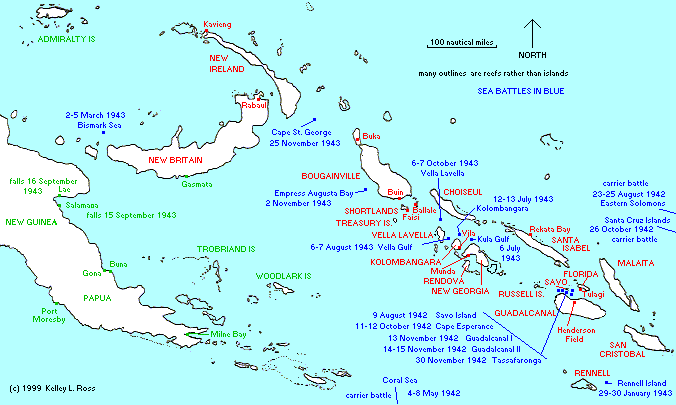 |
|
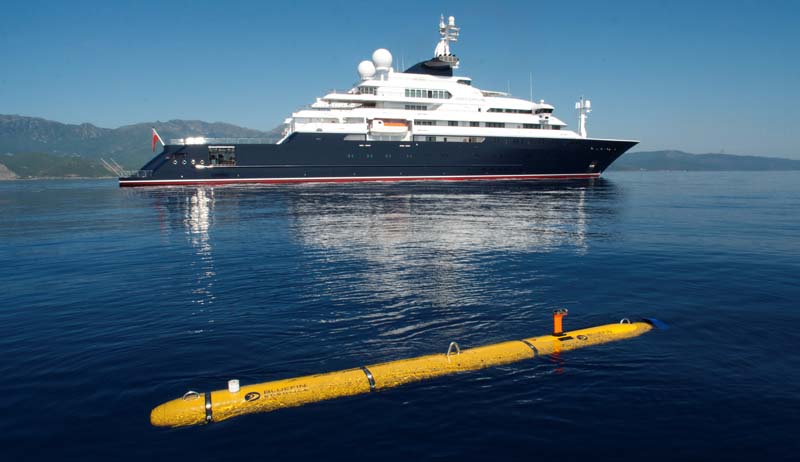 |
| Solomons Naval Battles. |
|
Bluefin ROV and Allen's MY OCTOPUS. |
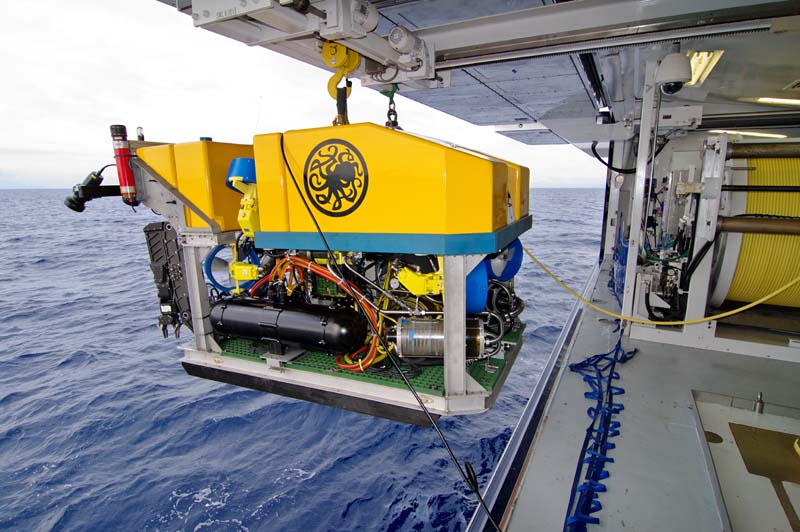 |
|
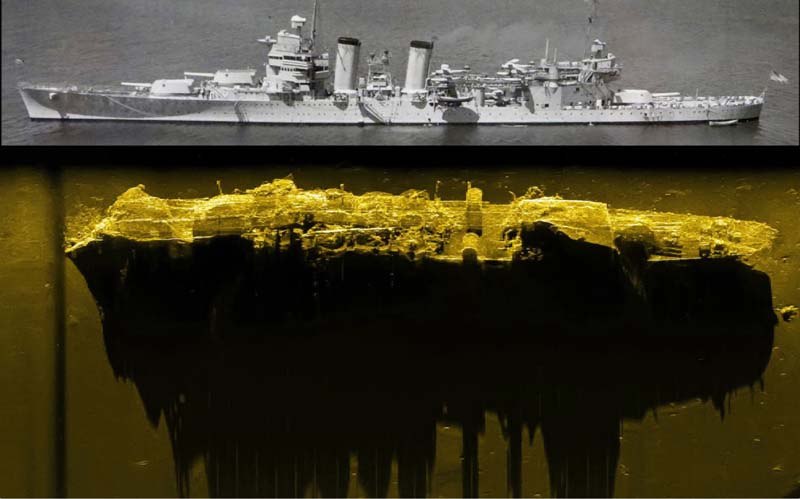 > > |
| 3000 meter rated ROV. |
|
ASTORIA's sonar image compared to photo image. |
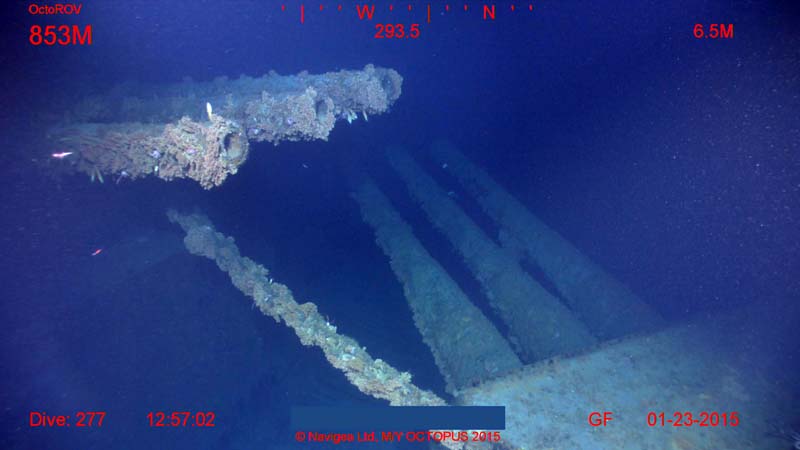 |
|
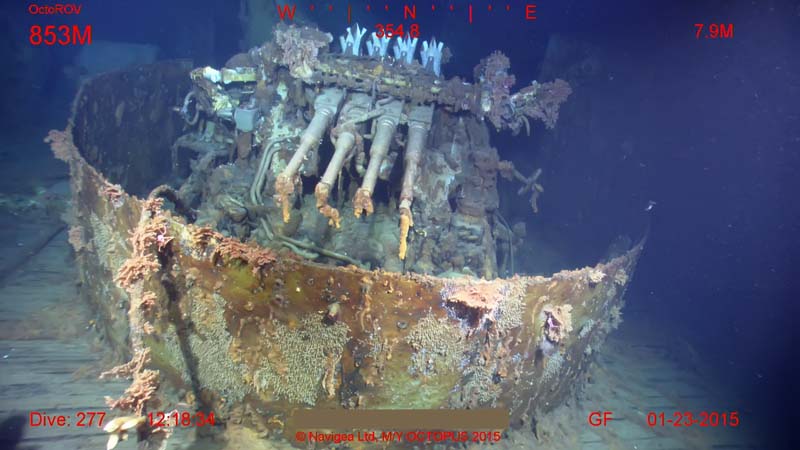 |
| ASTORIA's main gun turrets. |
|
ASTORIA's AA guns. |
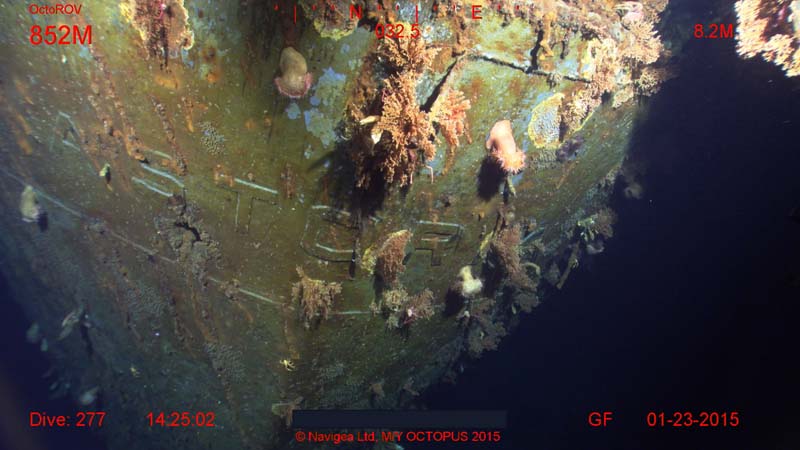 |
|
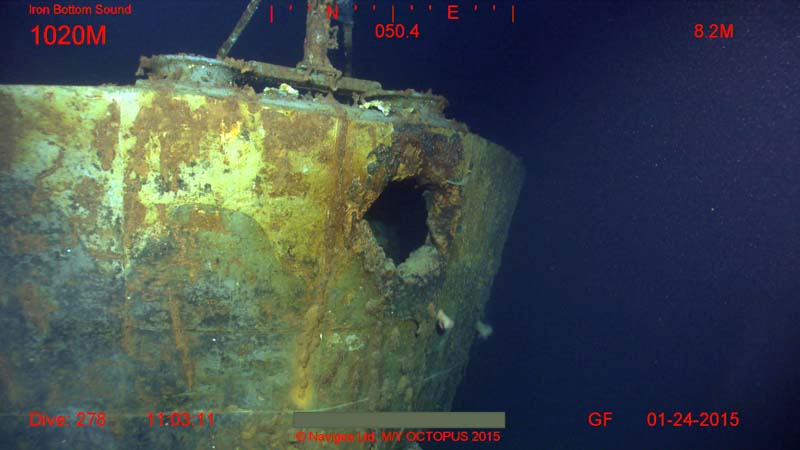 |
| ASTORIA's name on the stern. |
|
VINCENNES with IJN 8" AP shell hole in
stern. |
Authors' Notes:
[1] Mt. Niitaka, located in Formosa (now Taiwan), was the
highest point in the Japanese Empire at the time.
[2] Sources vary as to the number of ships (21-23) and the tonnage
(31,000-112,000) sunk by Ozawa's ships.
[3] Of the Allied cruiser commanders at Savo, both Captain Moore and
Captain Getting were mortally wounded, Captain Greenman survived and was
reassigned to the Service Force, Captain Riefkohl survived and became the Naval
Attache to Mexico and Captain Bode survived, but commited suicide a year later.
[4] Older sources suggest that CHOKAI was damaged on that day by a single
near miss scored by one of VS-10's dive-bombers. The first historian to correct
was John B. Lundstrom in his "The First Team and the Guadalcanal Campaign"
(1994).
[5] Aruga Kosaku's name is misspelled as Ariga Kosaku in several older
sources.
[6] A radio message received by YAMATO at 0918 refers to a bomb hit to
the forward engine room and suggests that the repairs were underway.
Special thanks for assistance in researching the IJN officers mentioned
in this TROM go to Mr. Jean-François Masson of Canada. Thanks also go again to
Aldert Gritter of the Netherlands, Andrew Obluski of Poland and Randy Stone of
the United States.
Thanks go to Don Kehn, Jr. for info on the sinking of SELMA CITY and
GANGES on 6 April 1942 and to the late John Whitman and Gengoro Toda of Japan
for info about stores ship KITAKAMI MARU.
Thanks also go to Rob Stuart of Canada for additional info about
"Operation C". For more info on "Operation C" please see Rob's splendid 20 Ships, Not 23: Ozawa’s
Score, 5-6 April 1942. NB: Older map on this TROM page erroneously shows 23
ships sunk.
Thanks also go to reader Larry McAneny for Rev 19.
- Bob Hackett and Sander Kingsepp.
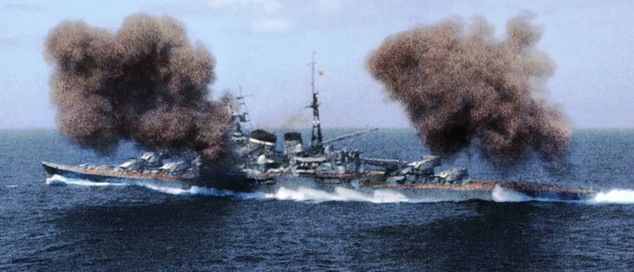

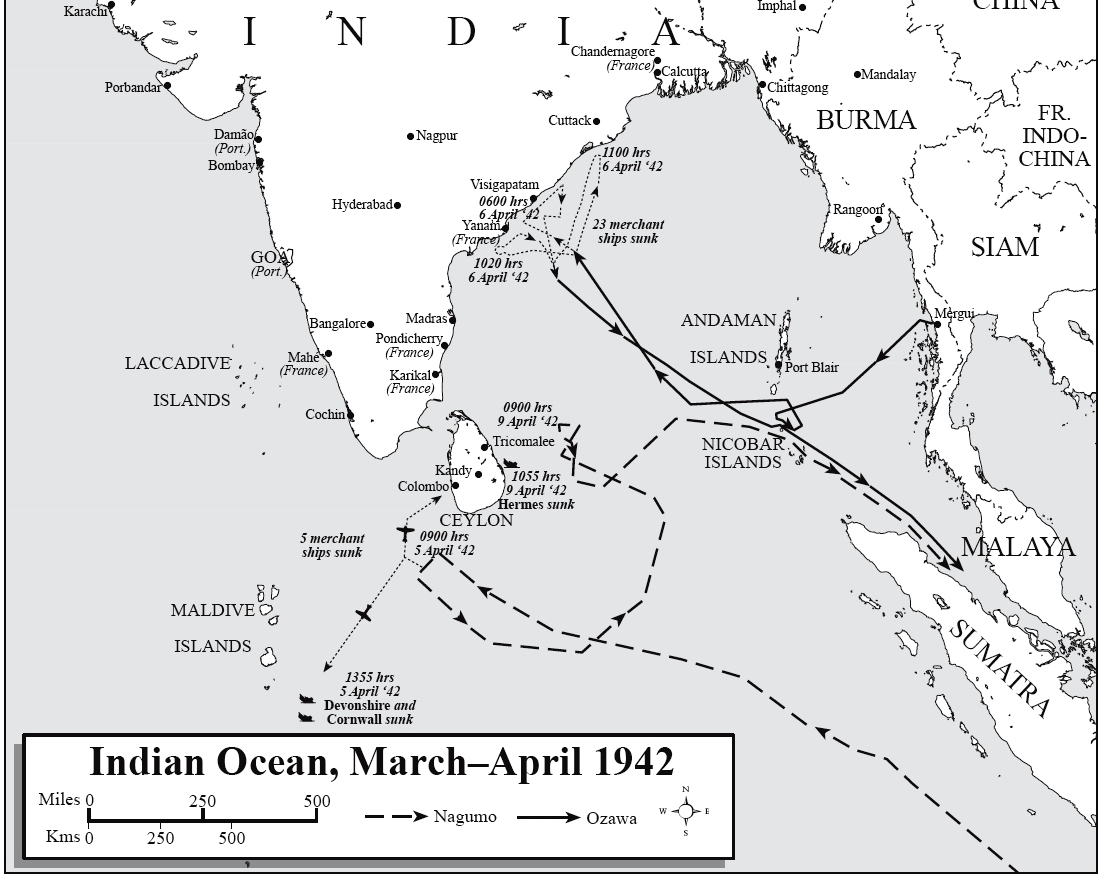



 >
>




